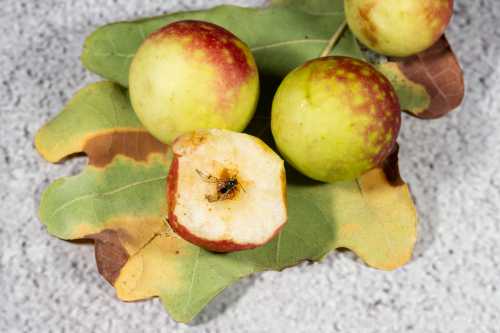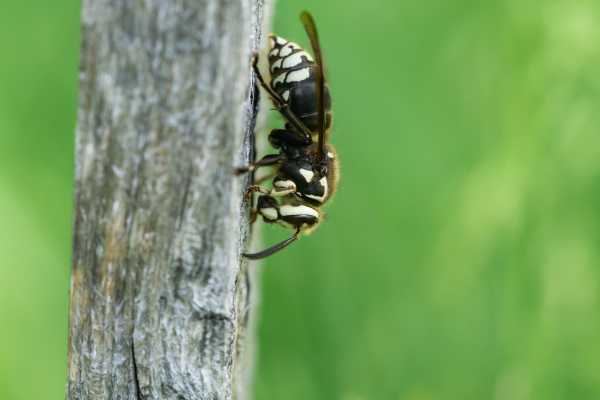Tarantula Hawk Wasp
Tarantula hawk wasps are a very beautiful type of spider wasp, famed for an incredibly painful sting (according to the Schmidt Pain Index1 - fortunately the pain only lasts about 3 minutes).
These long-legged wasps belong in the Pompilidae wasp family. This category of wasp is also referred to as 'the spider wasps'2,3,
Tarantula hawk wasps are one specific type of spider wasp, and the term 'tarantula hawk' refers to wasps belonging in the generas Pepsis and Hemipepsis2.
As the name suggests, they are also famous for capturing huge spiders - spiders that are significantly larger than themselves!
Life And Life Cycle Of The Amazing Tarantula Hawk Wasp!
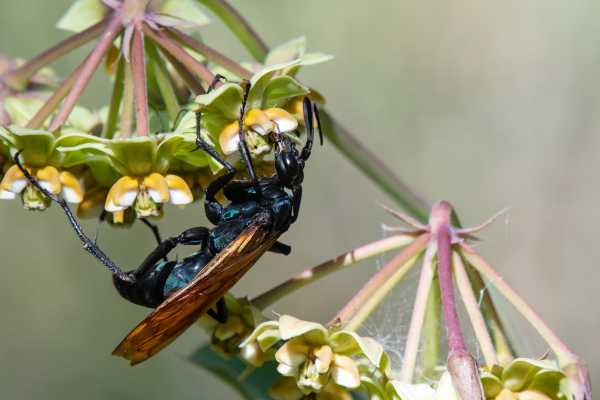
This very attractive insect is one of those creatures that literally makes me gasp in wonder.
It also has me completely on edge when I contemplate the dangerous job the female has of catching the prey it needs to feed its young.
If successful, the spider is paralyzed by the sting of the female wasp, and is then dragged back to the nest, whereupon the female wasp lays a single egg on top of the spider. The larva of the tarantula hawk then feeds on the spider as it develops and grows2,3.
Later, the larva spins a silken cocoon and pupates. In early season, the pupal stage may last only several weeks, and then an adult will emerge from the nest. Late season, the wasp will overwinter in the cocoon phase, and emerge the next spring4.
How can tarantula hawks catch spiders?
Here we apparently have a 'David and Goliath' of the invertebrate world. So how do tarantula hawks hunt spiders?
I love a particular comment by Eric R Heaton2.
"Females are in constant, feverish search for spider prey and with flicking wings and bobbing antennae, they appear nervous; if you were hunting spiders, you would be too".
Yes, despite being armed with a potent sting, female tarantula hawks have to be very careful, but fortunately, it appears the balance is tipped in their favour4. Tarantula hawks have a dense exoskeleton to help protect themselves against the spider's fangs, hopefully allowing them crucial seconds before they deliver their fatal sting. They may also emit an odour which assists them in some way, perhaps as a warning4.
Male tarantula hawk wasps should keep well away from spiders, however, since they do not possess a sting, and are completely harmless5.
You can watch my video of an incredible tarantula hawk wasp dragging a spider much larger than herself back to her nest, followed by a gallery of lovely spider wasps.
Further down this page, I also have a photograph of a wasp with a fairly massive spider - I thought I'd save it to the end!
Do tarantula hawks eat spiders?
Spiders are only eaten by the developing offspring of the adult tarantula hawks.
The adult wasps themselves don't feed on the spiders they catch. Instead, they feed on nectar, and they have been observed to feed on nectar from only a narrow range of flowers3.
Look out for Tarantula hawk wasps on the following flowers: Chilca (Baccharis latifolia), milkweed (Asclepias texana and A. sperryi), Mexican buckeye (Ungnadia speciosa), honey mesquite (Prosopis glandulosa)3 and Acacia greggii6.
Alternatively, if you want to see tarantula hawks, look down at the earth. As a result of their hunting and nest building activities, female spider wasps especially, may be seen running around on the ground. Males of some species may also be seen resting (or even mating with females) on the ground3.
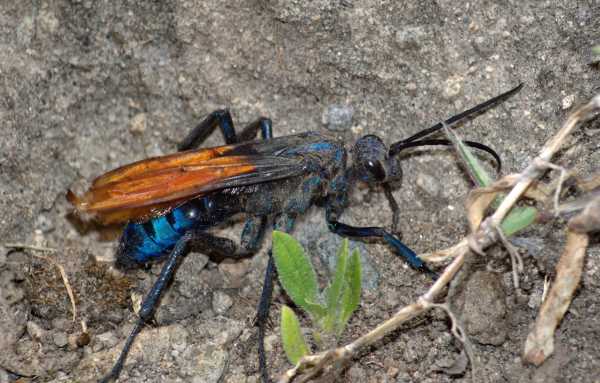 If you want to see a spider wasp, you could also try looking down. Tarantula hawk wasps can often be seen on the ground.
If you want to see a spider wasp, you could also try looking down. Tarantula hawk wasps can often be seen on the ground.How long do tarantula hawks live?
Adult males live a few weeks or so, whereas females can live four to five months4.
How big is a tarantula hawk wasp?
In size, Tarantula hawk wasps typically reach up to almost 2 inches (5 cm) in length, according to entomologist, Eric R. Heaton.
However, according to the Natural History Museum in London, the largest species of tarantula hawk is Pepsis heros, which can reach up to 11 centimetres long. This species is found in southeastern Peru7. The museum keeps a specimen of this insect at Hintze Hall.
From the excellent image below, you can see that Tarantula hawk wasps are significantly larger than honey bees (but they are apparently content to forage at close proximity on the same flower :).
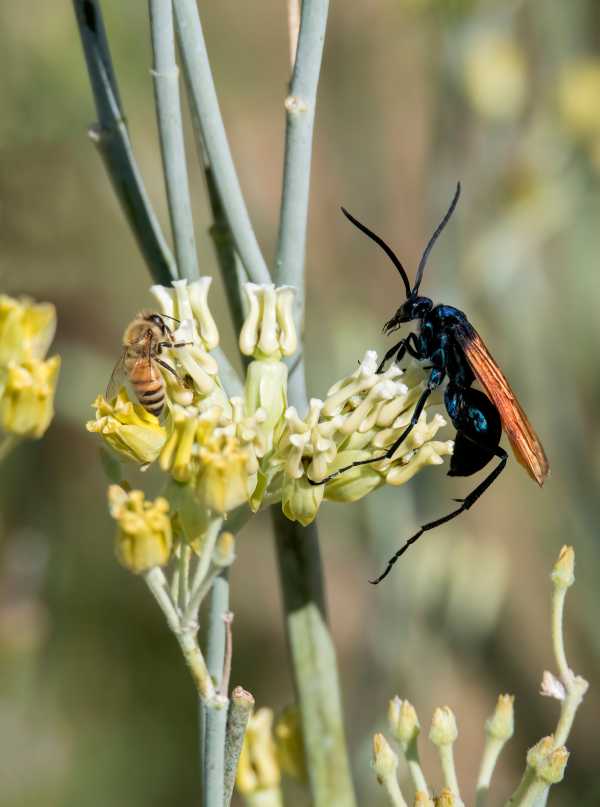 This excellent photograph provides a size comparison between a tarantula hawk wasp and honey bee foraging together on milkweed flower
This excellent photograph provides a size comparison between a tarantula hawk wasp and honey bee foraging together on milkweed flowerMating behaviour of spider wasps
Mating can occur on the ground3.
Some species such as Pepsis thisbe, have been observed to fly along patrol routes (or 'traplines') that might measure hundreds of meters in length, checking out trees, shrubs and other vegetation for females6.
In some species, such as Hemipepsis ustulata, males employ a landmark-defense mating system. A tree or a shrub is 'claimed' exclusively as territory by a single male. Females entering said male's patch are captured in mid air, whereupon the wasps fall briefly to ground as they mate briefly before the females fly off6.
Tarantula hawk wasp nests
Nests are dug into the earth by females, and depending on species, may be prepared either before or after hunting. In a few species, the wasp occupies the spider's own ground nest instead as is the case with the species Pepsis
cupripennis and Pepsis mildei3.
In species that dig their own nests, such as a species found in Columbia, Pepsis montezuma, a tunnel is excavated, measuring about 6.74 cm in length with a diameter of about 1.52 cm.
The tunnel widens to form a chamber where the female spider wasp deposits her spider prey3.
How many tarantula hawks are there, and where are they found?
To some extent, since there is so much conflicting information, I think it depends who you ask! It also depends whether or not the number quoted is for all spider wasp species rather than tarantula hawks specifically, whether information is up to date, whether both Pepsis and Hemipepsis are included in the figure, or whether or not the number is based on regional data only.
Just to make life a little more complicated, data on species is rarely static.
Schmidt states there are several hundred mostly tropical species, with about 25 species of Pepsis and Hemipepsis in America north of Mexico8.
Tarantula hawk wasp stings - Should I get rid of tarantula hawks?
Males tarantula hawks cannot sting, and whilst females are able to deliver a very painful sting, you can avoid being stung by simply leaving them alone.
These beauties also help keep check on large spider populations.
A sting from a tarantula hawk might hurt and deliver plenty of venom, but according to Schmidt, the venom itself lacks meaningful vertebrate toxicity8. Heaton points out that in a healthy human the pain lasts only about 3 minutes, and there is no resulting nerve or tissue damage2.
Finally, be aware that female tarantula hawks will give off pungent warning odour if caught4. In short, it's best to allow them to go about their business.
Now for that picture of a Tarantula hawk wasp, apparently facing off a huge spider - eeek!!! (Scroll down the page a little, if you're not too squeamish and you really want to see it!).
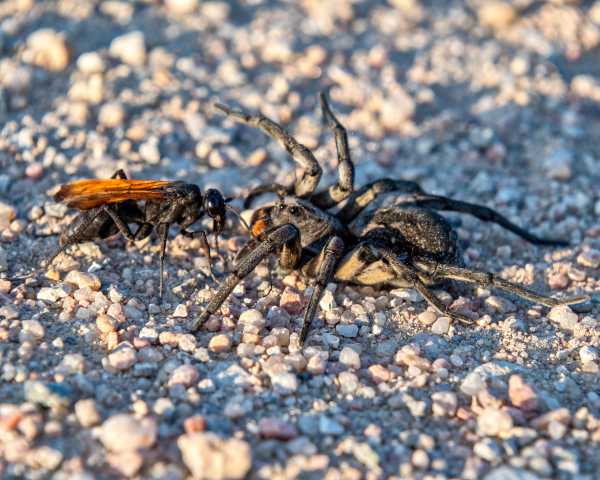
Well, I did warn you!
References
1. Read more on my page: Bees vs Wasp vs Hornet Stings
2. Eric R. Heaton; Wasps – The Astonishing Diversity Of A Misunderstood Insect, Princeton University Press 2021.
3. Restrepo-Giraldo, Carlos et al. “Temporal Activity Patterns of the Spider Wasp Pepsis montezuma Smith (Hymenoptera: Pompilidae) in a Disturbed Lower Montane Rainforest (Manizales, Colombia).” Psyche 2012 (2012): 1-4.
4. Justin O. Schmidt, The Sting of the Wild, Johns Hopkins Univ, $24.95 (320p) ISBN 978-1-4214-1928-2
5. Missouri Department of Conservation.
6. Alcock, John, and Michael D. Johnson. “Male Behavior in the Tarantula-Hawk Wasp Pepsis Thisbe Lucas (Hymenoptera: Pompilidae).” Journal of the Kansas Entomological Society, vol. 63, no. 3, 1990, pp. 399–404. JSTOR, http://www.jstor.org/stable/25085196. Accessed 20 Oct. 2023.
7. The Natural History Museum, London.
8. Justin O. Schmidt "Venom and the Good Life in Tarantula Hawks (Hymenoptera: Pompilidae): How to Eat, Not be Eaten, and Live Long," Journal of the Kansas Entomological Society 77(4), 402-413, (1 October 2004). https://doi.org/10.2317/E-39.1
If you found this page helpful or interesting, I'd really be grateful if you would share it with others - if not this page, perhaps another, such as Gardening For Bees.
Thank you so much :) .
